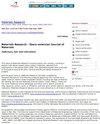基于有限元模拟的颗粒增强复合材料弹性参数预测
IF 1.3
4区 材料科学
Q4 MATERIALS SCIENCE, MULTIDISCIPLINARY
Materials Research-ibero-american Journal of Materials
Pub Date : 2023-05-01
DOI:10.1590/1980-5373-mr-2022-0475
引用次数: 0
摘要
本文章由计算机程序翻译,如有差异,请以英文原文为准。
Prediction of Elastic Parameters of Particle Reinforced Composites Using Finite Element Simulations
The macroscopic properties of composite materials depend on the microscopic properties of the constituents and the geometric arrangement of their phases. Therefore, it is essential to predict heterogeneous materials’ mechanical properties by simulating microstructural finite element models. The present article aims to analyze particle reinforced composites composed of spherical alumina inclusions surrounded by a glass matrix using a tridimensional representative volume element. Herein, microstructures are artificially created considering a regular or random arrangement of the inclusions. Two materials systems previously studied in the literature were analyzed. The discretization of the models was performed to have periodic mesh, thus enabling the use of periodic boundary conditions. A finite element model is created using Abaqus software. Numerical results show that the macroscopic properties can be estimated with high accuracy for the temperature where linear matrix behavior stands. The predictions were compared to experimental data from the literature. The models with a regular arrangement of inclusions show a difference inferior to 10%, while random arrangements show a difference inferior to 3.9%. The developed numerical algorithms can be modified to include new features, such as other dispersed phase arrangements or nonlinear material behavior.
求助全文
通过发布文献求助,成功后即可免费获取论文全文。
去求助
来源期刊

Materials Research-ibero-american Journal of Materials
MATERIALS SCIENCE, MULTIDISCIPLINARY-
CiteScore
2.40
自引率
11.80%
发文量
161
审稿时长
3 months
期刊介绍:
Information not localized
 求助内容:
求助内容: 应助结果提醒方式:
应助结果提醒方式:


